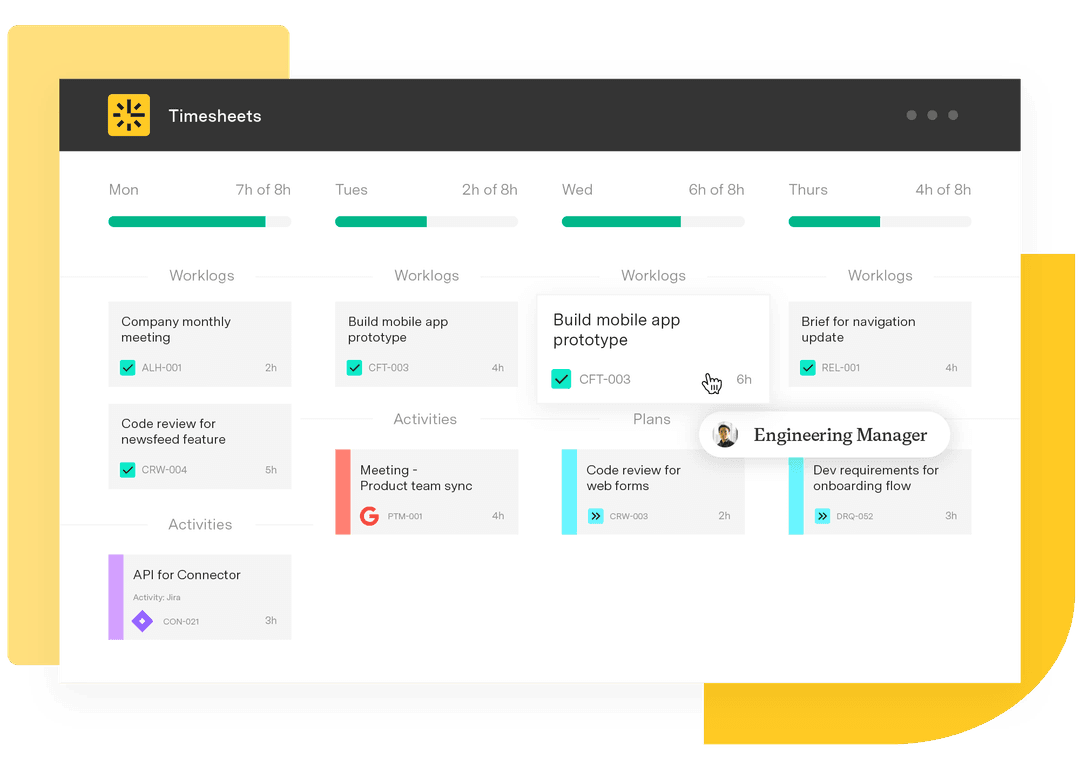Postmortem meeting: How to review and improve projects
Tempo Team
Once a project ends, it's tempting to jump straight into the next big task. But there’s value in pausing to ask: “What did we learn?”
A postmortem meeting gives your team a chance to celebrate what went well, identify areas for improvement, and create a roadmap for future success. This meeting turns every completed project into a learning opportunity that propels the team forward.
Let’s break down what postmortem means in business, why it matters, and how to lead a postmortem meeting that turns insights into lasting change.
What is a postmortem meeting?
A postmortem meeting, also known as a retrospective or event postmortem, is a structured opportunity for a team to reflect after a project or incident. It’s a chance to assess what went well, what didn’t, and how to improve moving forward. The goal is continuous improvement – learning from successes and setbacks to drive better results in future projects.
These meetings typically include the project manager and key project team members. Together, they revisit the original project plan and timeline, analyze any deviations, and identify opportunities to optimize processes. A clear agenda (or even a simple postmortem template or questionnaire) helps guide the discussion and turn insights into actionable steps.
Benefits of a postmortem meeting
It can be tempting to skip a postmortem review to save time, but doing so means missing valuable lessons that could improve future project planning and execution. When teams take the time to reflect, they grow with each project.
Here’s why postmortems matter:
Better team performance
Success doesn’t require a perfect project plan; it requires a team that learns and adapts. Postmortems allow everyone to reflect, share insights, and understand how their work fits into the bigger picture. When held regularly, these meetings enhance collaboration and help teams improve efficiency and outcomes.
Real transparency
A well-run postmortem creates space for honest conversations regarding misaligned expectations or parts of the project plan that fell short. This open dialogue builds trust and helps teams navigate future challenges together.
Fewer repeated mistakes, more repeatable wins
Mistakes are inevitable, but repeating them isn’t. Whether it’s a minor bug in a sprint or a breakdown in stakeholder feedback, a structured postmortem helps teams identify root causes and develop strategies to avoid them in the future. These discussions directly contribute to smarter risk management plans and stronger execution over time.
Higher morale – even when things didn’t go perfectly
Postmortems examine what didn’t work, but they also provide an opportunity to highlight what did. Recognizing the team’s effort, creativity, and progress – despite any bumps along the way – ends the project on a positive note. This acknowledgement boosts morale and fuels momentum for the next phase, reinforcing the value of each team member’s contributions.
Actionable improvements
Whether you discover the need to refine workflows, update project templates, or optimize meeting agendas, a postmortem meeting turns feedback into actionable steps. The insights gained become integral to your team’s future operations.
How to run a postmortem meeting
A productive postmortem meeting offers an opportunity to strengthen processes and improve future performance. However, without a clear structure, it can quickly become a blame session or vague recap. Follow these steps to keep the meeting focused and action-oriented:
1. Schedule the meeting promptly
Aim to hold the postmortem within a week or two after the project ends. Waiting too long can result in forgotten details, lost documents, and disengaged participants. A timely meeting ensures everyone can recall specifics, such as missed deadlines or last-minute adjustments.
However, be mindful of the team’s energy levels. If the project was particularly demanding, give them a few days to recharge.
2. Gather project data
Before the meeting, compile relevant data to guide the discussion, including:
The project plan
Relevant communication threads
Deliverables
Client or stakeholder feedback
The final project schedule
If you're using time-tracking tools like Timesheets, pull performance data to understand how the team allocated time across different project phases.
Remember, a postmortem is also an opportunity to celebrate successes. For example:
Which sprint adhered most closely to the timeline?
What decisions helped prevent delays?
Which task handoffs went smoothly?
This evidence-based approach supports a balanced, actionable postmortem review.
3. Invite key contributors
A successful postmortem meeting requires the right mix of voices, which includes anyone whose work influenced the outcome.
Invite stakeholders who had visibility into capacity planning and execution. IT teams should include someone from DevOps or support to offer additional insights. Assign a moderator to guide the conversation and a note-taker to document key points.
4. Set a clear agenda
A strong meeting agenda provides structure and prevents the session from drifting into unproductive venting. Follow a classic retrospective format (what went well, what didn’t, what can improve) or customize a postmortem template to suit your team's needs.
Consider including:
A brief recap of the project’s goals and outcome
Identification of major obstacles and their root causes
Reflections on team collaboration, handoffs, and communication
Opportunities for process improvements
Assignment of next steps and action items
5. Foster open communication
A successful postmortem meeting relies on honest feedback from all participants. To ensure everyone has a voice, consider collecting feedback beforehand using a short questionnaire. This gives quieter team members a chance to contribute and helps the moderator identify potential issues or patterns in advance.
During the meeting, create an environment where even junior team members feel comfortable sharing their perspectives. Transparent, candid feedback is invaluable, and it’s the leader’s responsibility to foster openness throughout the discussion.
6. Share insights and assign actions
A postmortem in business is only effective if it leads to tangible change. After the meeting, share a clear, concise summary of the discussion, including key takeaways, action items, assigned owners, and timelines for completion. Use your project management platform or Jira dashboards to track progress.
If your team struggles with follow-up, try these strategies:
Set reminders or calendar holds for check-ins
Assign a follow-up lead to encourage accountability
Include postmortem follow-up in sprint planning or stand-ups
This approach embeds improvements into daily workflows and prevents the same issues from resurfacing months later.
Turning retrospective insights into action with Tempo
A productive postmortem meeting is only the first step. The real value lies in turning insights into lasting improvements.
That’s where Tempo’s project management tools can help. Timesheets lets you track time spent on specific tasks and compare it to outcomes, helping you assess the impact of the changes discussed during the postmortem. Custom Charts for Jira visualizes this progress, keeping your team aligned and focused on continuous improvement.
By connecting lessons learned to clear, trackable action items, you ensure nothing falls through the cracks.
Ready to turn your postmortems into real results? Try Tempo today.













































